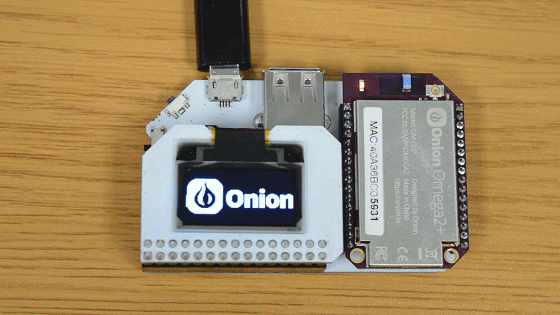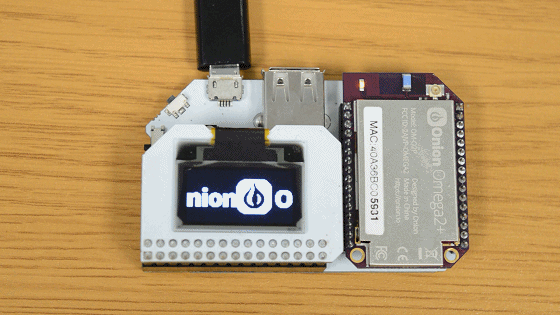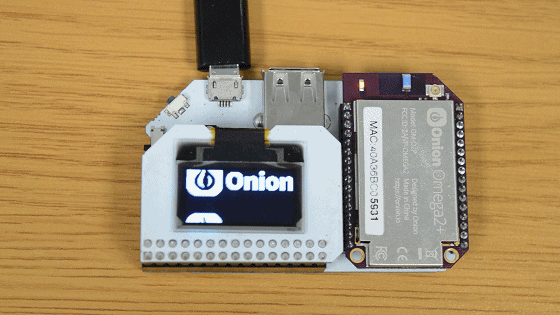Using the OLED Expansion
The OLED Expansion is an extremely power efficient 0.96″ monochrome (black and white) OLED display for your Omega. With a resolution of 128×64, it is very handy for displaying text, drawing images, and even animation!
We’ve developed a command line tool called oled-exp that will be your helper in all things related to the OLED Expansion.
Also available are a C library and a Python module that allow you to develop your own programs to control the OLED Expansion. See the guides at the bottom of this article for more details.

You can learn more about the technical specifications of the OLED expansion in our OLED Expansion hardware overview
Command Usage
To use your OLED display you’ll first need to initialize the display:
oled-exp -i If you do not initialize your display then your OLED Expansion will not respond to other commands.
For a print-out of the command’s usage, run it with only a -h argument:
oled-exp -hIn general, the commands will be in this form:
oled-exp [OPTIONS] <COMMAND> <PARAMETER>Command and Option Table
To reconcile all of the above features to oled-exp, refer to the table below:
| Action | Option/Command |
|---|---|
| initialization | -i |
| clear the display | -c |
| toggle display on or off | power <on/off> |
| invert colours | invert <on/off> |
| dim the screen | dim <on/off> |
| set the cursor | cursor <row>,<column> |
| set the cursor by pixel | cursorPixel <row>,<pixel> |
| write text | write <string> |
| write a single byte | writeByte <byte> |
| enable scrolling | scroll <direction> |
| display an image | draw <lcd file> |
Options
The option arguments can be run by themselves or in conjunction with any other command. They will always be executed first.
Initialization
To initialize the display to accept further commands:
// just initialize the display
oled-exp -i
// initialize the display and write a message
oled-exp -i write "Freshly initialized"Clear the Screen
To clear the screen and set the cursor to the top left:
// just clear the screen
oled-exp -c
// clear the screen and draw an image
oled-exp -c draw /root/onion.lcdCommands
The commands are more complex and each requires one argument.
Power
Turn the display on or off. Can be used to toggle the display after it has been initialized.
oled-exp power <on|off>Note that any text or images on the screen will be preserved.
Invert
Invert black and white on the display. Setting to on will enable the invert, setting to off will disable the inversion.
oled-exp invert <on|off>Dim
Enable dimming the display. Setting to on will dim the display, setting to off will restore the default brightness.
oled-exp dim <on|off>Write
Write a string to the display at the current position of the cursor:
oled-exp write <string>If the string contains spaces or any special characters (newlines, !?(){}[] etc), it needs to be wrapped with double quotes:
oled-exp write "This is so exciting!\nIsn't it?!?!\n\n(I love the Omega)"A list outlining the supported characters can be found in a section below.
Write a Single Byte
Write a single byte of data (eight vertical pixels) to the display at the current position of the cursor:
oled-exp writeByte <byte>The Least Significant Bit (LSB) in the byte corresponds to the top-most pixel in the column, the Most Significant Bit (MSB) corresponds to the bottom-most pixel in the column.
The cursor will be incremented to the next pixel column after this command.
For example, the following command:
oled-exp writeByte 0x0fWill fill in the top four pixels and will leave the bottom four pixels in a column blank.
0x0freads as00001111in binary.
Set the Cursor Position
Set the cursor position on the display, any writes after this command will start at the specified row and column.
The row parameter represents each character row (8 pixel rows) on the display, so the range is 0 to 7
The column parameter represents each character column, the range is 0 to 20
oled-exp cursor <row>,<column>Examples
To write Hello on the first line, and then How are you? on the 4th row:
oled-exp write Hello cursor 3,0 write "How are you?"Set the cursor to the start of the last character row:
oled-exp cursor 7,0Set the cursor to the middle of the 2nd row:
oled-exp cursor 2,10Set the Cursor Position by Pixel Column
Set the cursor position on the display, any writes after this command will start at the specified row and pixel.
The row parameter represents each character row (8 pixel rows) on the display, so the range is 0 to 7
The pixel parameter represents each pixel column, the range is 0 to 127
oled-exp cursorPixel <row>,<pixel>Examples
To write Hello a quarter of the way through the first line, and then How are you? in the middle of the 4th row:
oled-exp cursorPixel 0,31 write Hello cursorPixel 3,63 write "How are you?"Set the cursor to the start of the last character row:
oled-exp cursorPixel 7,0Set the cursor to the middle of the 2nd row:
oled-exp cursorPixel 2,63Scrolling
The OLED can scroll whatever is on the screen horizontally or diagonally upwards. The text/image will wrap around the edges.
oled-exp scroll <direction>Supported directions: * left * right * diagonal-left * diagonal-right * stop * This is to disable scrolling.


Drawing Images on the Display
The OLED Screen can also be used to display images. The Console can be used to convert existing images into a format that is compatible with the OLED Expansion and save the output to an Omega. Functions in the C library can read the image data and display it on the OLED Expansion. Alternatively, a buffer can be created programatically and displayed on the OLED.
Creating Image Files
The Console OLED App can be used to create OLED Expansion compatible image files. Navigate to the Image tab of the OLED App:

Once an image has been selected, a button and form will appear that allow you to save the OLED image file to your Omega:

After the image name and location are selected, click the Save to Omega button.
OLED Image File Details
The OLED image files store the image data as 1024 bytes represented in hexadecimal. Each byte represents eight vertical pixels, with the first 128 bytes representing the columns in Page 0, the following 128 bytes representing the columns in Page 1, and so on.
If this is unclear, see the Understanding the Display Section in the OLED Expansion Library documentation article for details on how the display is addressed.
Displaying Images from a File
To display the OLED image file on the OLED Expansion:
oled-exp draw <path to oled image file>Example
Draw an image saved to /root/image.lcd on the display:
oled-exp draw /root/image.lcdInitialize the display and draw an image saved to /tmp/onion.lcd:
oled-exp -i draw /tmp/onion.lcdSupported Characters
The OLED Display supports the following characters:
SPACE, !, ", #, $, %, &, ', (, )
, * , + , , , - , . , / , 0 , 1 , 2 , 3 , 4 , 5 , 6 , 7 , 8 , 9 , a , b , c , d , e , f , g , h , i , j , k , l , m , n , o , p , q , r , s , t , u , v , w , x , y , z , A , B , C , D , E , F , G , H , I , J , K , L , M , N , O , P , Q , R , S , T , U , V , W , X , Y , Z , : , ; , < , = , > , ? , @ , [ , \ , ] , ^ , _ , ` , { , | , } , ~Using the Libraries
The C library and Python module will give you the flexibility to use the OLED Expansion however you want in your own programs.
For more information, see our guide to using the OLED Expansion C Library, or our guide to using the OLED Expansion Python Module.